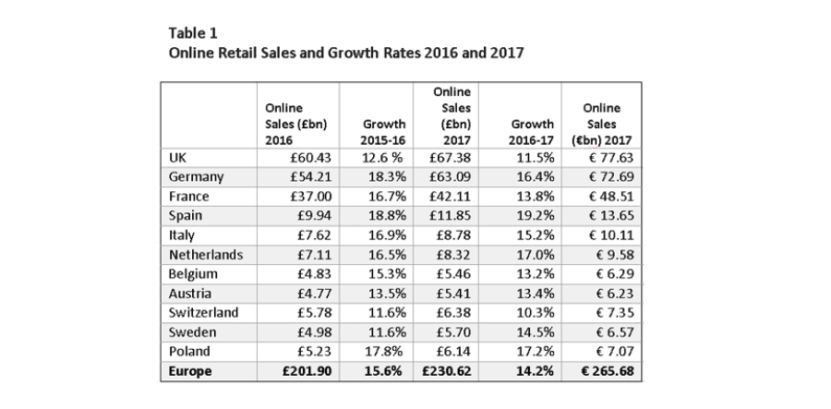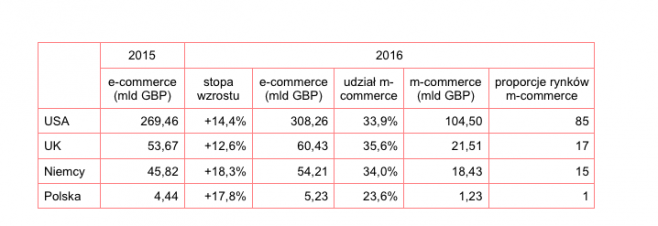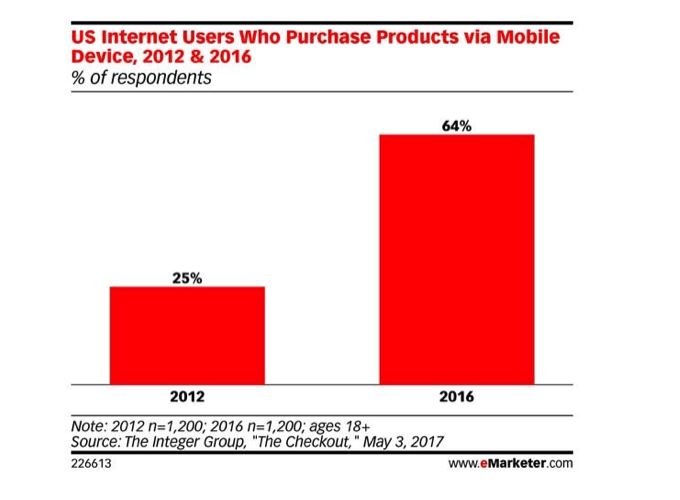Americans, Germans, Poles, Brits go shopping less and less often
This time I’m serving up a large dose of e-commerce numbers, albeit useful, my own calculations. If there are too many, I apologize and invite you to the end of the text, to summarize. However, before you scroll the screen, please noteómend the narrow definition of retail used by the Centre for Retail Research (CRR), which excludes spending on shopping m. in. banking services, travel agency servicesóry, ticketóin shopping for cars, car fuels, in cafes and restaurants. Usually estimates of the value of e-commerce in Poland are higher (e.g. Chamber of Electronic Commerce), as they include a broader definition of the concept.
According to eMarketer.com, already nearly 2/3 of internet usersóin the U.S., i.e more than 130 million people, shop via mobile devices (four years earlier it was just 1/4 of American adultsów).
In 2016 the value of mobile commerce in the U.S. exceeded dizzying – as per European and Polish realities – total over 104 billion poundsóin sterlingóin (GBP) (sic and please do not confuse with dollars or euros; for simplicity we use data from the sourceóThe average CRR quoted in GBP – The share of mobile in e-commerce was 33.9%.
For leekóThe most popular mobile devices in the world are „mobilised” European country – in the UK – The share of m-commerce was slightly higher and accounted for 35.6% of the total online retail market, while in the case of our western neighbors the share of m-commerce in the total online retail market wasóat 34%, and 23.4% on average in Europe (much lower than in the US). The value of the m-commerce market in the UK is 21.51 billion GBP, in Germany 18.43 billion GBP (based on data from the Centre for Retail Research and my own calculations).
More and more Americansóin does shopping online. Less and less people go shopping or buy less. But it’s not just them, Europeans too. Thanks to smartphones and tablets, shopping literally just „come” to people everywhere – even the most intimate one and at any time – zamóonline rallies can take place in any of the 24 hours of the day. If we also take into account the development ofóThe use of conversational marketing and the use of chatbotóin and virtual assistantsów, or artificial intelligence tools, as I wrote about in previous weeks, proper shopping can do itself.
The web sucks you into shopping
Online commerce is the fastest growing retail market in Europe. In 2016, its value in the countries surveyed increased by 15.6%. The three largest countries (UK, Germany and France) accounted for 75% of online sales. In the current year, further growth is expected – by 14.2%, to GBP 230 billion.

SourceóSource: Centre for Retail Research
In tróThe fastest growing market in the worldóThe most popular online shopping destination in Europe is Poland. In 2016 the e-commerce market in our country urógrowth of 17.8%, to £5.23bn – 27.94 billion PLN after conversion (annual weighted average exchange rate in PLN, NBP). In 2017, spending is expected to increase by a similar proportion, to £6.14 billionów.
Poland compared to others
According to the report „E-commerce in Poland 2016 Gemius for e-Commerce Poland” Internet users indicated that already 41% of them use a smartphone in the process of making a purchaseóonline, a 24% from tablets.
In contrast, Statista for 2015 reports that m-commerce accounted for 13.9% of e-commerce in Poland. Based on the market’s year-on-year growth rate, the estimated value of e-commerce was £4.44 billionów. Thus, the value of mobile commerce in Poland in 2015 was GBP 0.62 billion (PLN 3.56 billion). Taking 100% as the growth rate in 2016 and 50% in 2017, we get GBP 1.23 billion (PLN 6.59 billion) in 2016 and £1.85 billion in 2017. Estimated share of m-commerce in e-commerce 23.6% in 2016 and even 30.2% this year.

sourceóSource: Own calculations based on eMarketer, Centre for Retail Research and Statista
The proportion of the market sizeóin the móhow many times a given market is larger than the Polish one in terms of value. Despite the rapid growth of trade via mobile devices, The Polish m-commerce market is still 15 times smaller than the German market! However, it is comforting to know that we belong to the group of immature marketóThe mobile sector is a very important part of the e-commerce market (it also includes Italy and Spain), with a high potential for growth, and that there are 2-3 years of solid growth ahead of usóin, during whichóWe need to overcome technical barriers (10 times less data than inó(especially in smaller centers). The reach should also increase, especially in terms ofólnie regularity of purchaseóonline.
Thanks to these factors, we should catch up with the distance from the largest marketsów.


